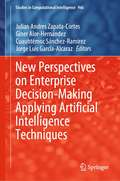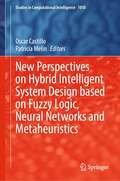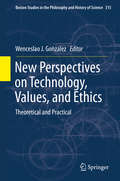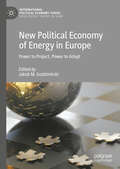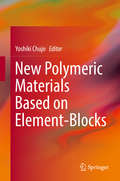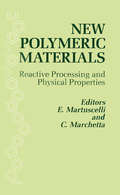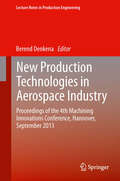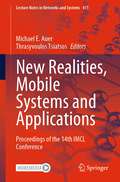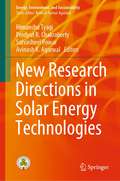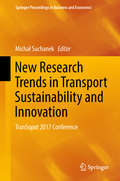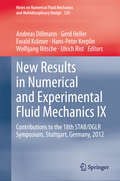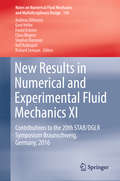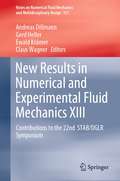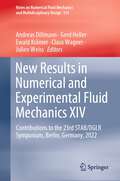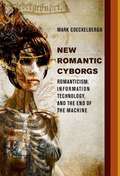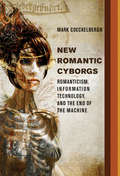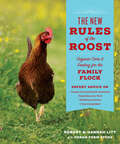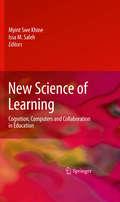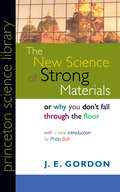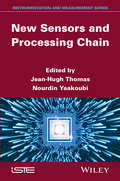- Table View
- List View
New Perspectives on Enterprise Decision-Making Applying Artificial Intelligence Techniques (Studies in Computational Intelligence #966)
by Julian Andres Zapata-Cortes Giner Alor-Hernández Cuauhtémoc Sánchez-Ramírez Jorge Luis García-AlcarazThis book presents different techniques and methodologies that used to help improve the decision-making process and increase the likelihood of success in sector as follows: agriculture, financial services, logistics, energy services, health and others. This book collects and consolidates innovative and high-quality research contributions regarding the implementation techniques and methodologies applied in different industrial sectors. The scope is to disseminate current trends knowledge in the implementation of artificial intelligence techniques and methodologies in different fields as follows: supply chain, business intelligence, e-commerce, social media and others. The book contents are useful for Ph.D., Ph.D. students, master and undergraduate students, and professional and students in industrial engineering, computer science, information systems, data analytics and others.
New Perspectives on Hybrid Intelligent System Design based on Fuzzy Logic, Neural Networks and Metaheuristics (Studies in Computational Intelligence #1050)
by Oscar Castillo Patricia MelinIn this book, recent developments on fuzzy logic, neural networks and optimization algorithms, as well as their hybrid combinations, are presented. In addition, the above-mentioned methods are applied to areas such as, intelligent control and robotics, pattern recognition, medical diagnosis, time series prediction and optimization of complex problems. The book contains a collection of papers focused on hybrid intelligent systems based on soft computing techniques. There are some papers with the main theme of type-1 and type-2 fuzzy logic, which basically consists of papers that propose new concepts and algorithms based on type-1 and type-2 fuzzy logic and their applications. There also some papers that offer theoretical concepts and applications of meta-heuristics in different areas. Another group of papers describe diverse applications of fuzzy logic, neural networks and hybrid intelligent systems in medical problems. There are also some papers that present theory and practice of neural networks in different areas of application. In addition, there are papers that present theory and practice of optimization and evolutionary algorithms in different areas of application. Finally, there are some papers describing applications of fuzzy logic, neural networks and meta-heuristics in pattern recognition and classification problems.
New Perspectives on Nonlinear Dynamics and Complexity (Nonlinear Systems and Complexity #35)
by Dimitri Volchenkov Albert C. J. LuoThis book presents select, recent developments in nonlinear and complex systems reported at the 1st Online Conference on Nonlinear Dynamics and Complexity, held on November 23-25, 2020. It provides an exchange recent developments, discoveries, and progresses in Nonlinear Dynamics and Complexity. The collection presents fundamental and frontier theories and techniques for modern science and technology, stimulates more research interest for exploration of nonlinear science and complexity; and passes along new knowledge and insight to the next generation of engineers and technologists in a range of fields.
New Perspectives on Technology, Values, and Ethics
by Wenceslao J. GonzalezThis book focuses on a key issue today: the role of values in technology, with special emphasis on ethical values. This topic involves the analysis of internal values in technology (as they affect objectives, processes, and outcomes) and the study of external values in technology (social, cultural, economic, ecological, etc. ). These values -- internal and external -- are crucial to the decision making of engineers. In addition, they have increasing relevance for citizens concerned with the present and future state of technology, which gives society a leading position in technological issues. The book follows three main lines of research: 1) new perspectives on technology, values, and ethics; 2) rationality and responsibility in technology; and 3) technology and risks. This volume analyzes the two main sides involved here: the theoretical basis for the role of values in technology and a practical discussion on how to implement them in our society. Thus, the book is of interest for philosophers, engineers, academics of different fields and policy-makers. The style used lends itself to broad audience.
New Political Economy of Energy in Europe: Power To Project, Power To Adapt (International Political Economy)
by Jakub M. GodzimirskiThis edited collection details and analyses the dramatic changes that the international political economy of energy has undergone in the past decade. This change began with the increasing assertiveness of Russia when the oil price rose above the $100 mark in 2008. This, combined with the rise of shale oil and gas, made the USA all but self-sufficient in terms of fossil fuels. The collapse of the oil price in 2014-15, Saudi Arabia’s new strategy of defending its market share and the increasingly tense and controversial relationship between the West and Russia all worked to further strengthen the geopolitical dimension of energy in Europe. The global result is a world in which geopolitics play a bigger part than ever before; the central question the authors of this volume grapple with is how the EU – and European small states – can deal with this.Chapter 4 of this book is available open access under a CC BY 4.0 license at link.springer.com
New Polymeric Materials Based on Element-Blocks
by Yoshiki ChujoThis book introduces the recent progress that has resulted from utilizing the idea of "element-block polymers". A structural unit consisting of various groups of elements is called an "element-block." The design and synthesis of new element-blocks, polymerization of these blocks, and development of methods of forming higher-order structures and achieving hierarchical interface control in order to yield the desired functions are expected to result in manifold advantages. These benefits will encourage the creation of new polymeric materials that share, at a high level, electronic, optical, and magnetic properties not achievable with conventional organic polymeric materials as well as forming properties of molding processability and flexible designability that inorganic materials lack. By pioneering innovative synthetic processes that exploit the reactivity of elements and the preparation techniques employed for inorganic element-blocks, the aim is (1) to create a new series of innovative polymers based on the novel concept of element-block polymers, in which the characteristics of elements are extensively combined and utilized, and (2) to formulate theories related to these polymers. This book demonstrates especially the design strategies and the resulting successful examples offering highly functional materials that utilize element-block polymers as a key unit.
New Polymeric Materials: Reactive Processing and Physical Properties
by E. Martuscelli; C. MarchettaThe development of new polymeric materials has caused a considerable expansion in the field of reactive processing. These new materials are very competitive compared to the traditional ones with respect to production costs and performance. The reports published in this volume present the recent developments and emerging trends in the field of reactive processing and the physical properties of the resulting polymeric materials. Special attention is given to the chemical, kinetic and rheological aspects of reactive processing.
New Polymers for Encapsulation of Nutraceutical Compounds
by Jorge Carlos Ruiz Ruiz Maira Rubi Segura CamposThe incorporation of functional ingredients in a given food system and the processing and handling of such foods are associated with nutritional challenges for their healthy delivery. The extreme sensitivity of some components cause significant loss of product quality, stability, nutritional value and bioavailability, and the overall acceptability of the food product. Consequently, encapsulation has been successfully used to improve stability and bioavailability of functional ingredients. Encapsulation is one example of technology that has the potential to meet the challenge of successfully incorporating and delivering functional ingredients into a range of food types. The book will cover topics about 1) Characterization of novel polymers and their use in encapsulation processes. 2) Stability of nutraceutical compounds encapsulated with novel polymers. 3) Application of encapsulated compounds with novel polymers in functional food systems. This book provides a detailed overview of technologies for preparing and characterisation of encapsulates for food active ingredients using modified polymers. The use of modified polymers as coating materials it is a field that still needs study. The book is aimed to inform students and researchers in the areas of food science and food technology, and professionals in the food industry.
New Production Technologies in Aerospace Industry
by Berend DenkenaThis contributed volume contains the research results presented at the 4th Machining Innovations Conference, Hannover, September 2013. The topic of the conference are new production technologies in aerospace industry and the focus is on energy efficient machine tools as well as sustainable process planning. The target audience primarily comprises researchers and experts in the field but the book may also be beneficial for graduate students.
New Realities, Mobile Systems and Applications: Proceedings of the 14th IMCL Conference (Lecture Notes in Networks and Systems #411)
by Michael E. Auer Thrasyvoulos TsiatsosThis book devotes to new approaches in interactive mobile technologies with a focus on learning. Interactive mobile technologies are today the core of many—if not all—fields of society. Not only the younger generation of students expects a mobile working and learning environment. And nearly daily new ideas, technologies and solutions boost this trend.To discuss and assess the trends in the interactive mobile field are the aims connected with the 14th International Conference on Interactive Mobile Communication, Technologies and Learning (IMCL2021), which was held online from 4 to 5 November 2021.Since its beginning in 2006, this conference is devoted to new approaches in interactive mobile technologies with a focus on learning. Nowadays, the IMCL conferences are a forum of the exchange of new research results and relevant trends as well as the exchange of experiences and examples of good practice. Interested readership includes policy makers, academics, educators, researchers in pedagogy and learning theory, school teachers, learning Industry, further education lecturers, etc.
New Research Directions in Solar Energy Technologies (Energy, Environment, and Sustainability)
by Himanshu Tyagi Prodyut R. Chakraborty Satvasheel Powar Avinash K. AgarwalApplications of solar energy have been expanding in recent years across the world. This monograph details such far-reaching and important applications which have the potential for large impact on various segments of the society. It focuses solar energy technologies for various applications such as generation of electric power, heating, energy storage, etc. This volume will be a useful guide for researchers, academics and scientists.
New Research Trends in Transport Sustainability and Innovation: Transopot 2017 Conference (Springer Proceedings In Business And Economics)
by Michał SuchanekThis proceedings volume examines the effects of transport on socio-economic development including innovation, public health and cultural behavior. Featuring contributions presented at the 2017 TranSopot Conference in Sopot, Poland, the enclosed papers are divided to provide emerging research in transport sustainability, innovation, structure, and in municipal transport economics. Collectively, the contributions provide not only the theoretical background for transport analysis but also empirical data and practical applications. Researchers in the transport sector strive to explore the nuances of various aspects of transport economics, which are connected on many levels. The sustainability of transport fits into a wide perspective of the sustainable economy. It treats the activities of individuals, companies and local, regional and national governments as means of achieving economic and social ends. Conversely, transport sustainability has a certain burden on society as it may generate external costs in the form of congestion, pollution and negative health effects. Many of these adverse effects might be counteracted by transport innovations, both the technical ones and the organizational ones. These innovations, while their main goal might be to increase the efficiency of the transport entities, should also fit into the desirable trend of responsible economic design thinking. These general ideas of transport research naturally have to influence the research in various branches of transport ranging from the road transport to railway. Lastly, there is the municipal transport, in which goals of different stakeholders are often contradictory which leads to highly complicated decision problems. Featuring case examples on topics as bike sharing, green travel, compact cars, freight transport and electric cars, this book will be of interest to researchers, practitioners, policy makers and students in the fields of transport economics, innovation, and sustainability.
New Results in Numerical and Experimental Fluid Mechanics IX
by Andreas Dillmann Gerd Heller Ewald Krämer Hans-Peter Kreplin Wolfgang Nitsche Ulrich RistThis book presents contributions to the 18th biannual symposium of the German Aerospace Aerodynamics Association (STAB). The individual chapters reflect ongoing research conducted by the STAB members in the field of numerical and experimental fluid mechanics and aerodynamics, mainly for (but not limited to) aerospace applications, and cover both nationally and EC-funded projects. By addressing a number of essential research subjects, together with their related physical and mathematics fundamentals, the book provides readers with a comprehensive overview of the current research work in the field, as well as its main challenges and new directions. Current work on e. g. high aspect-ratio and low aspect-ratio wings, bluff bodies, laminar flow control and transition, active flow control, hypersonic flows, aeroelasticity, aeroacoustics and biofluid mechanics is exhaustively discussed here.
New Results in Numerical and Experimental Fluid Mechanics X
by Andreas Dillmann Gerd Heller Ewald Krämer Claus Wagner Christian BreitsamterThis book presents contributions tothe 19th biannual symposium of the German Aerospace Aerodynamics Association(STAB) and the German Society for Aeronautics and Astronautics (DGLR). Theindividual chapters reflect ongoing research conducted by the STAB members inthe field of numerical and experimental fluid mechanics and aerodynamics,mainly for (but not limited to) aerospace applications, and cover bothnationally and EC-funded projects. Special emphasis is given to collaborativeresearch projects conducted by German scientists and engineers fromuniversities, research-establishments and industries. By addressing a number ofcutting-edge applications, together with the relevant physical and mathematicsfundamentals, the book provides readers with a comprehensive overview of thecurrent research work in the field. Though the book's primary emphasis is onthe aerospace context, it also addresses further important applications, e. g. in ground transportation and energy.
New Results in Numerical and Experimental Fluid Mechanics XI
by Andreas Dillmann Gerd Heller Ewald Krämer Claus Wagner Stephan Bansmer Rolf Radespiel Richard SemaanThis book gathers contributions to the 20th biannual symposium of the German Aerospace Aerodynamics Association (STAB) and the German Society for Aeronautics and Astronautics (DGLR). The individual chapters reflect ongoing research conducted by the STAB members in the field of numerical and experimental fluid mechanics and aerodynamics, mainly for (but not limited to) aerospace applications, and cover both nationally and EC-funded projects. Special emphasis is given to collaborative research projects conducted by German scientists and engineers from universities, research-establishments and industries. By addressing a number of cutting-edge applications, together with the relevant physical and mathematics fundamentals, the book provides readers with a comprehensive overview of the current research work in the field. Though the book's primary emphasis is on the aerospace context, it also addresses further important applications, e. g. in ground transportation and energy.
New Results in Numerical and Experimental Fluid Mechanics XII: Contributions to the 21st STAB/DGLR Symposium, Darmstadt, Germany, 2018 (Notes on Numerical Fluid Mechanics and Multidisciplinary Design #142)
by Andreas Dillmann Gerd Heller Ewald Krämer Claus Wagner Cameron Tropea Suad JakirlićThis book gathers contributions to the 21st biannual symposium of the German Aerospace Aerodynamics Association (STAB) and the German Society for Aeronautics and Astronautics (DGLR). The individual chapters reflect ongoing research conducted by the STAB members in the field of numerical and experimental fluid mechanics and aerodynamics, mainly for (but not limited to) aerospace applications, and cover both nationally and EC-funded projects. Special emphasis is given to collaborative research projects conducted by German scientists and engineers from universities, research-establishments and industries. By addressing a number of cutting-edge applications, together with the relevant physical and mathematics fundamentals, the book provides readers with a comprehensive overview of the current research work in the field. The book’s primary emphasis is on aerodynamic research in aeronautics and astronautics, and in ground transportation and energy as well.
New Results in Numerical and Experimental Fluid Mechanics XIII: Contributions to the 22nd STAB/DGLR Symposium (Notes on Numerical Fluid Mechanics and Multidisciplinary Design #151)
by Andreas Dillmann Gerd Heller Ewald Krämer Claus WagnerThis book offers timely insights into research on numerical and experimental fluid mechanics and aerodynamics, mainly for (but not limited to) aerospace applications. It reports on findings by members of the STAB (German Aerospace Aerodynamics Association) and DGLR (German Society for Aeronautics and Astronautics) and covers both nationally and EC-funded projects. Continuing on the tradition of the previous volumes, the book highlights innovative solutions, promoting translation from fundamental research to industrial applications. It addresses academics and professionals in the field of aeronautics, astronautics, ground transportation, and energy alike.
New Results in Numerical and Experimental Fluid Mechanics XIV: Contributions to the 23rd STAB/DGLR Symposium, Berlin, Germany, 2022 (Notes on Numerical Fluid Mechanics and Multidisciplinary Design #154)
by Andreas Dillmann Gerd Heller Ewald Krämer Claus Wagner Julien WeissThis book offers timely insights into research on numerical and experimental fluid mechanics and aerodynamics, mainly for (but not limited to) aerospace applications. It reports on findings by members of the Deutsche Strömungsmechanische Arbeitsgemeinschaft, STAB (German Aerodynamics/Fluid Mechanics Association) and the Deutsche Gesellschaft für Luft- und Raumfahrt - Lilienthal Oberth e.V., DGLR (German Society for Aeronautics and Astronautics) and covers both nationally and EC-funded projects. Continuing on the tradition of the previous volumes, the book highlights innovative solutions, promoting translation from fundamental research to industrial applications. It addresses academics and professionals in the field of aeronautics, astronautics, ground transportation, and energy alike.
New Romantic Cyborgs: Romanticism, Information Technology, and the End of the Machine
by Mark CoeckelberghRomanticism and technology are widely assumed to be opposed to each other. Romanticism -- understood as a reaction against rationalism and objectivity -- is perhaps the last thing users and developers of information and communication technology (ICT) think about when they engage with computer programs and electronic devices. And yet, as Mark Coeckelbergh argues in this book, this way of thinking about technology is itself shaped by romanticism and obscures a better and deeper understanding of our relationship to technology. Coeckelbergh describes the complex relationship between technology and romanticism that links nineteenth-century monsters, automata, and mesmerism with twenty-first-century technology's magic devices and romantic cyborgs.Coeckelbergh argues that current uses of ICT can be interpreted as attempting a marriage of Enlightenment rationalism and romanticism. He describes the "romantic dialectic," when this new kind of material romanticism, particularly in the form of the cyborg as romantic figure, seems to turn into its opposite. He shows that both material romanticism and the objections to it are still part of modern thinking, and part of the romantic dialectic. Reflecting on what he calls "the end of the machine," Coeckelbergh argues that to achieve a more profound critique of contemporary technologies and culture, we need to explore not only different ways of thinking but also different technologies -- and that to accomplish the former we require the latter.
New Romantic Cyborgs: Romanticism, Information Technology, and the End of the Machine (The\mit Press Ser.)
by Mark CoeckelberghAn account of the complex relationship between technology and romanticism that links nineteenth-century monsters, automata, and mesmerism with twenty-first-century technology's magic devices and romantic cyborgs.Romanticism and technology are widely assumed to be opposed to each other. Romanticism—understood as a reaction against rationalism and objectivity—is perhaps the last thing users and developers of information and communication technology (ICT) think about when they engage with computer programs and electronic devices. And yet, as Mark Coeckelbergh argues in this book, this way of thinking about technology is itself shaped by romanticism and obscures a better and deeper understanding of our relationship to technology. Coeckelbergh describes the complex relationship between technology and romanticism that links nineteenth-century monsters, automata, and mesmerism with twenty-first-century technology's magic devices and romantic cyborgs.Coeckelbergh argues that current uses of ICT can be interpreted as attempting a marriage of Enlightenment rationalism and romanticism. He describes the “romantic dialectic,” when this new kind of material romanticism, particularly in the form of the cyborg as romantic figure, seems to turn into its opposite. He shows that both material romanticism and the objections to it are still part of modern thinking, and part of the romantic dialectic. Reflecting on what he calls “the end of the machine,” Coeckelbergh argues that to achieve a more profound critique of contemporary technologies and culture, we need to explore not only different ways of thinking but also different technologies—and that to accomplish the former we require the latter.
The New Rules of the Roost: Organic Care and Feeding for the Family Flock
by Hannah Litt Robert Litt“The Litts listen daily to concerns and questions posed by customers seeking the best organic methods for keeping backyard chickens safe and healthy. Now they’ve compiled their proven solutions into this often-entertaining book.” —Gail Damerow, author of The Guide to Raising Chickens New from Robert and Hannah Litt—the authors of the bestselling A Chicken in Every Yard—comes a hardworking guide to backyard chicken keeping that goes beyond the basics. The New Rules of the Roost addresses the real problems that crop up when keeping chickens long term. The Litts cover a wide range of topics including organic health remedies and disease prevention, pest management, organic nutrition, the best breeds for specific needs, and the simplest options for daily maintenance and feeding. You'll also learn tips and tricks for introducing new birds into your flock, managing aggressive behavior, caring for mature chickens, and much more.
New Science of Learning
by Myint Swe Khine Issa M. SalehThe earliest educational software simply transferred print material from the page to the monitor. Since then, the Internet and other digital media have brought students an ever-expanding, low-cost knowledge base and the opportunity to interact with minds around the globe--while running the risk of shortening their attention spans, isolating them from interpersonal contact, and subjecting them to information overload. The New Science of Learning: Cognition, Computers and Collaboration in Education deftly explores the multiple relationships found among these critical elements in students' increasingly complex and multi-paced educational experience. Starting with instructors' insights into the cognitive effects of digital media--a diverse range of viewpoints with little consensus--this cutting-edge resource acknowledges the double-edged potential inherent in computer-based education and its role in shaping students' thinking capabilities. Accordingly, the emphasis is on strategies that maximize the strengths and compensate for the negative aspects of digital learning, including: Group cognition as a foundation for learning Metacognitive control of learning and remembering Higher education course development using open education resources Designing a technology-oriented teacher professional development model Supporting student collaboration with digital video tools Teaching and learning through social annotation practices The New Science of Learning: Cognition, Computers and Collaboration in Education brings emerging challenges and innovative ideas into sharp focus for researchers in educational psychology, instructional design, education technologies, and the learning sciences.
The New Science of Strong Materials: Or Why You Don't Fall Through The Floor (Princeton Science Library)
by J. E. GordonJ. E. Gordon’s classic introduction to the properties of materials used in engineering answers some fascinating and fundamental questions about how the structural world around us works. Gordon focuses on so-called strong materials--such as metals, wood, ceramics, glass, and bone--explaining in engaging and accessible terms the unique physical and chemical basis for their inherent structural qualities. He also shows how an in-depth understanding of these materials’ intrinsic strengths--and weaknesses--guides our engineering choices, allowing us to build the structures that support our society. This work is an enduring example of first-rate scientific communication. Philip Ball’s introduction describes Gordon’s career and the impact of his innovations in materials research, while also discussing how the field has evolved since Gordon wrote this enduring example of first-rate scientific communication.
The New Science of Strong Materials: Or Why You Don't Fall Through the Floor
by J E GordonWhy isn't wood weaker that it is? Why isn't steel stronger? Why does glass sometimes shatter and sometimes bend like spring? Why do ships break in half? What is a liquid and is treacle one? All these are questions about the nature of materials. All of them are vital to engineers but also fascinating as scientific problems. During the 250 years up to the 1920s and 1930s they had been answered largely by seeing how materials behaved in practice. But materials continued to do things that they "ought" not to have done. Only in the last 40 years have these questions begun to be answered by a new approach. Material scientists have started to look more deeply into the make-up of materials. They have found many surprises; above all, perhaps, that how a material behaves depends on how perfectly - or imperfectly - its atoms are arranged. Using both SI and imperial units, Professor Gordon's account of material science is a demonstration of the sometimes curious and entertaining ways in which scientists isolate and solve problems.
New Sensors and Processing Chain
by Nourdin Yaakoubi Jean-Hugh ThomasA vital tool for researchers, engineers, and students, NewSensors and Processing Chain focuses on the processing chain toset up in order to extract relevant information on various systems.Highlighting the design of new microsensors and variousapplications, the authors present recent progress ininstrumentation and microsystem design, providing insight to themodification of the sensor itself as well as its environment.Various applications illustrate the presentations, which show how aprocessing chain is organized from the data acquired by a specificsensor.
